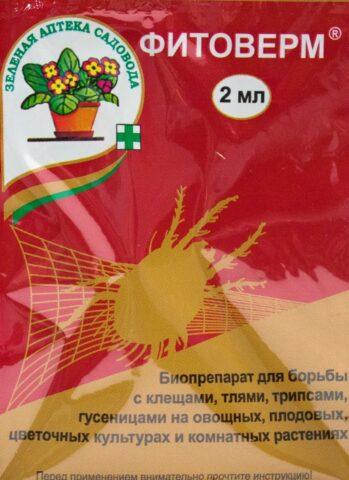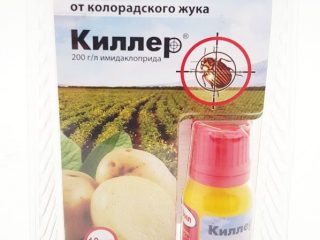Content
Thrips appear on cucumbers quite often, especially in a greenhouse, where there are all favorable conditions for their life and reproduction. This leads to a decrease in yield, and in the absence of timely control measures, to the death of plants. Therefore, it is important that every gardener is able to recognize damage at the initial stage. The sooner the pest is identified, the less damage it will cause to cucumbers. Otherwise, it will spread to other crops, leading to more significant losses.

Tobacco and greenhouse thrips can be found on cucumbers
Description of the pest
Thrips (Thysanoptera) are small flying insects from the order Fringed Ptera. They have an oblong body, the length of which is 1-3 mm. The color of the pest can be brown, black, gray, depending on the variety. The mouthparts of thrips are of the piercing-sucking type.
Insects have three pairs of legs. They lack claws, but have teeth and suction cups, which allow them to be held on the back of the leaves of cucumbers and other crops.Adults are capable of flying short distances. The wings of thrips are narrow, covered with a fringe of cilia.
Females are larger than males. They are characterized by increased fertility. Every 7-10 days, a thrips colony can double in size if conditions are favorable.
Reasons for appearance
These pests overwinter in the top layer of soil and plant debris. And if no measures have been taken to destroy them since the fall, then they will definitely appear next season.
You can introduce thrips into a garden or greenhouse with low-quality humus, mulch, or with newly acquired seedlings of other crops.
Provoking factors contributing to their mass reproduction:
- close placement of plants that are susceptible to thrips attack;
- lack of fertilizing to help increase the immunity of cucumbers;
- dense plantings.
What do cucumbers affected by thrips look like?
The danger of thrips is that they are difficult to detect at the initial stage of the lesion. After all, they live on the back side of leaves and only with mass reproduction do obvious signs of their vital activity appear. The photo shows what the leaves of cucumber seedlings look like when they are infected with thrips.

When affected by thrips, metabolic processes in the leaves and shoots of cucumbers are disrupted
Characteristic signs indicating the presence of a pest:
- small light dots, stripes on the plates, which subsequently noticeably increase in size;
- premature leaf fall;
- sugary secretions on the plant;
- deformation of buds, tops of lashes;
- slow development;
- shedding of the ovary;
- dejected appearance.
What harm can they cause?
Adults and larvae of the pest feed on plant cell sap. This leads to a weakening of their vitality. As a result, the development of cucumbers is initially slowed down and subsequently stopped. This leads to drying out of the ovary and fruits.
Thrips are also dangerous because they are carriers of viral diseases that cannot be treated. If characteristic signs appear, the affected cucumbers must be destroyed.
How to get rid of thrips on cucumbers
To combat greenhouse and tobacco thrips on cucumbers, comprehensive measures should be used. These include chemicals, biologicals and traps. Only in this case can you get rid of the pest and prevent its massive spread.
Chemical preparations for thrips on cucumbers
Knowing what thrips look like on cucumbers in a greenhouse and in open ground, you can start fighting them in a timely manner. The use of special chemicals in this case helps to quickly reduce the number of pests. But the destructive effect of the drugs applies only to adults and larvae. After all, the poison does not penetrate the shell of the eggs. In view of this, chemicals should be used several times every seven days. =
Effective preparations for treating cucumber seedlings against thrips:
- Aktellik;
Actellik has contact-intestinal and fumigation effects
- Vertimek;
Vertimek suppresses larval activity two hours after application
- Spark;
Spark provides protection for three weeks
- Inta-Vir.
Inta-Vir is effective not only against thrips, but also all types of aphids and whiteflies
Biological agents
Due to the rapid fruiting of cucumbers, it is not always possible to use chemicals to treat them against thrips. After all, they have a long waiting period before harvesting. In this case, it is recommended to give preference to biological products.
The most effective of them:
- Guapsin. This biological product combines insecticidal and fungicidal properties. Guapsin begins to work 36-48 hours after treatment. The duration of the protective effect is seven days. Dilute with water in a ratio of 1:40.
Guapsin can be combined with many drugs in one tank mixture
- Acto effect. A biological product that has insecticidal and acaricidal properties. It is of natural origin. To treat cucumbers against thrips, you need to add 10 ml of the drug per 1 liter of water and mix. This product does not pose a danger to the environment and humans if the instructions for use are followed.
Acto effect cannot be used during flowering
- Fitoverm. This drug begins to act 2-3 hours after treatment, and causes the death of thrips on 3-5 days. Its active component is a substance produced by soil microorganisms. To prepare a working solution, dilute 2 ml of the product in 250 ml of water. This drug is non-phytotoxic and safe for bees and fish.
The waiting period after treating cucumbers with Fitoverm is two days.
Traps
Special glue traps also help to cope with the invasion of thrips on cucumbers.They should have a yellow or blue tint that attracts the attention of pests. To catch thrips, it is enough to install one trap for every 8-10 square meters. m. But it should be understood that this method of control helps to get rid of adult flying individuals. And the larvae and eggs are immune to it.
How to fight thrips on cucumbers using folk remedies
When thrips appear on cucumber seedlings, treatment can also be carried out using folk remedies. They give good results with a small number of pests. They are also recommended to be used to prevent infection.
Ammonia
To treat cucumbers against thrips, you can use ammonia, the smell of which repels pests. To do this, you need to dilute the product with water in a ratio of 1:20. Spray the cucumber leaves with the solution, wetting them evenly. Repeat the procedure every 10-14 days.
Tar soap
To combat thrips, you need to rub 100 g of tar soap and add 1.5 liters of hot water. Then the mixture should be thoroughly stirred until smooth. Before use, the resulting concentrate should be diluted with water in a ratio of 1:2 and sprayed on cucumbers.
It is recommended to repeat the treatment every ten days throughout the entire growing season of the crop.
Other
To protect cucumbers from thrips, you can also use less common folk remedies. However, they are not inferior in effectiveness to ammonia and tar soap.
Other folk remedies against thrips on cucumbers:
- Tobacco dust. To prepare a working solution, you need to pour 100 g of this component into 1 liter of water and simmer the mixture over low heat for half an hour. Then the product must be left for a day. Before use, it should be strained and diluted with water 1:2.
- Garlic.Grind ten cloves of the vegetable to a paste-like consistency. Pour the mixture into 2 liters of water and leave for 24 hours. Then strain and spray the leaves on the reverse side. Repeat the procedure every ten days
- Chamomile flowers. Pour 100 g of plant collection into 1 liter of water. Leave the product for 12 hours. Before use, strain and add a little green soap. Spray cucumbers with the resulting product regularly every seven days.
- Celandine. To combat thrips, the flowers of this plant are needed. To prepare an effective remedy, you should pour 400 g of fresh raw materials or 100 g of dried collection into 1 liter of water and leave for 24 hours. After time, strain the product and dilute it with water 1:2. Use it to spray cucumbers every week throughout the growing season.

Folk remedies have a contact effect and are washed off by rain
Prevention measures
To prevent the appearance of thrips on cucumbers and other crops, it is necessary to adhere to certain preventive measures. They cannot completely eliminate damage, but they reduce this likelihood to a minimum.
Basic preventive measures:
- removal and burning of plant residues;
- deep digging of the site in the fall;
- timely weeding and fertilizing;
- seed treatment before sowing;
- watering the soil with insecticides in the spring before planting seedlings;
- compliance with crop rotation.
Conclusion
Thrips on cucumbers can appear at any time. To prevent their mass spread, you need to regularly inspect the seedlings and react at the first suspicious signs. Otherwise, this pest can nullify all the efforts of the gardener.















